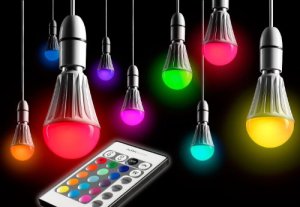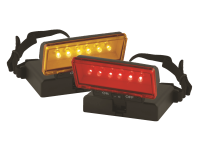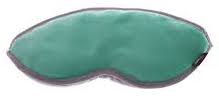 The Sunrise System SRS100 is the second dawn simulator that I tried, after I found the Lumie Bodyclock to be too limited. I like being able to choose exactly what sort of light I have by my bed and where it is positioned, and using a plug-in dawn simulator allowed me to do exactly that. In fact, it even allowed me to take my partner’s light preferences into consideration. If you use a multiway plug, you can hook up as many lamps as you like, provided that the total wattage does not exceed 300W (Europe model) or 200W (USA model). You could light up the entire room on that, if you wished. It needs to be straightforward lamp that does not include a dimmer function already (so touch lamps are out), and you have to use the right kind of bulb (standard incandescent and dimmable energy-saving halogen are fine; fluorescent, LED, or ordinary halogen won’t do), but apart from that, any lamp will do. If you want to put in a “special daylight bulb”, which used to mean a “neodymium” incandescent bulb with a lavender coating but now means a dimmable halogen (both are meant to produce a whiter light, tbut he dimmable halogen does a better job and is a lot easier and cheaper to find, not to mention energy-saving), then you can. I’d suggest using the energy-saving dimmable halogen, not just for those reasons but also because with the best will in the world, dawn simulators are prone to buzzing when standard incandescents are used, and they don’t do this at all with dimmable halogen.
The Sunrise System SRS100 is the second dawn simulator that I tried, after I found the Lumie Bodyclock to be too limited. I like being able to choose exactly what sort of light I have by my bed and where it is positioned, and using a plug-in dawn simulator allowed me to do exactly that. In fact, it even allowed me to take my partner’s light preferences into consideration. If you use a multiway plug, you can hook up as many lamps as you like, provided that the total wattage does not exceed 300W (Europe model) or 200W (USA model). You could light up the entire room on that, if you wished. It needs to be straightforward lamp that does not include a dimmer function already (so touch lamps are out), and you have to use the right kind of bulb (standard incandescent and dimmable energy-saving halogen are fine; fluorescent, LED, or ordinary halogen won’t do), but apart from that, any lamp will do. If you want to put in a “special daylight bulb”, which used to mean a “neodymium” incandescent bulb with a lavender coating but now means a dimmable halogen (both are meant to produce a whiter light, tbut he dimmable halogen does a better job and is a lot easier and cheaper to find, not to mention energy-saving), then you can. I’d suggest using the energy-saving dimmable halogen, not just for those reasons but also because with the best will in the world, dawn simulators are prone to buzzing when standard incandescents are used, and they don’t do this at all with dimmable halogen.
From reading a large number of dawn simulator reviews, while a small number of people are choosy about the exact colour of the light they wake up to, far more are concerned with the brightness. Reviewers of all-in-one models frequently complain that the light is not bright enough to wake them up (or read by), and very occasionally complain that it’s too bright for them. The ability to select exactly how long the dawn simulation takes appears to be another key issue. Nor does this type of dawn simulator ever cause problems with not liking the appearance of the lamp (several brands are frequently slated as producing ugly, cheap-looking lamps), or having to replace the entire unit when the built-in bulb dies (this problem appears to occur only with the Philips Wake-Up Light). This unit is not going to win any art awards (I’ve yet to see any type of light therapy device which will), but it’s fairly standard-looking for this sort of gadget and is reasonably small and neat at 11.5 x 13 x 7.5 (base)/3 (top) cm. The picture above is showing it next to a fairly small lamp.
Being able to choose exactly what sort of light you use, where you position it and how long it takes to come on, is a joy, especially if you have a partner and the two of you have slightly different tastes in this department. I’m perfectly happy to be woken by a fairly strong light after half an hour, but my partner finds it much too bright when he’s still at that stage of waking up. After some experimentation, we put a stronger bulb on my side of the bed than on his, and set the dawn simulation to take an hour so that we’re getting up while the light is still softer and don’t have to face bright light until we’re more awake.
Dawn simulation is originally intended to be used while asleep, but we’ve somehow ended up using it while we’re dozing and then getting up, as my partner prefers to have several sound alarms starting at the same time that the dawn simulation starts. It still works: we wake up feeling more refreshed and we find it easier to wake up at the same time every day. We both find that about fifteen or so minutes into it, we’re not at all keen on this whole morning idea and may even try to hide under the quilt if we’re awake enough, but by the time the light is fully on, we’re up and doing. I’ve also used dawn simulation in the conventional fashion in the past, when it would feel as if I simply blinked and was peacefully awake, rather than being dragged painfully into consciousness by an alarm clock.
In the new model (more on this below), Morning Sunrise have put in a couple of features which I wasn’t sure about at first but now rather like. The first is that when you simply turn the lamp on or off, it fades up/down over two seconds instead of coming on instantly. This took me a while to get used to, but it can be soothing, and it’s mostly useful for when you want to turn the lamp off and then get out of the bedroom without tripping over in the dark. The other feature is that if you let the dawn simulator come on and don’t do anything to it (I think this only applies when the sound alarm is off, otherwise you have to press a button), the light will stay on for an additional hour, turn off, and the dawn simulator will automatically come on the next day. This is handy for people who may forget to turn their dawn simulator on every day, and also people who dash out of the house in the morning and can’t remember whether they turned the light off or not. I presume the hour is to give you time to shower, dress, breakfast and so forth. I’m often still in my bedroom after that hour, so I just turn the lamp on again using the snooze button. I’ve also just been reminded that the extra hour is useful as a back-up if you’re not properly woken by the dawn simulation, for example if you snooze for a while after awakening.
This lamp also has a number of other features which I don’t use but other people may find useful. There’s an optional nightlight which is adjustable, so that you can set it to come on as brightly as you please. Obviously I’m not keen on nightlights that have any blue light in them as they will suppress melatonin production, but incandescent and dimmable halogen bulbs produce very yellow light when they’re that dim and there won’t be much blue in there, so most people will be happy with this. (It’s certainly better than some of the nightlights you can buy which produce bluish white light, the last thing they should do.) There’s a “security” setting that will put the lamp on at random intervals as a burglar-deterrent if you’re away.
The majority of these are features that you’re not going to get with an all-in-one dawn simulator, where you’re lucky if you can change the length of time the sunrise/sunset takes, and the cost of the Sunrise Syste, SRS100 is equivalent to the cheapest end of the all-in-ones, at least the decent models. (There are a few cheap and nasty things out there, which can generally be spotted because they cost a tenner new on eBay and get diabolical reviews on Amazon.) To compare to Lumie’s all-in-one range, you have to spend £99.95 with Lumie before you can vary the length of the sunrise/sunset (though they don’t offer 45 or 75 min) and £149.95 before you get seven-day alarm settings, and even then you may find that the lamp is too dim to read by. On the other hand, the SRS100 doesn’t include sleep sounds, a radio or anything else like that. Morning Sunrise offers more expensive models with those features if you want them, and come to that they also offer several fully-featured all-in-one models as well.
As with all dawn simulators, there’s an optional back-up sound if light isn’t enough to wake you reliably every single morning. The sound it makes is absolutely horrible. It beeps once, then twice, then three times, and I don’t think I’ve ever been able to stand it for longer than that. Some people prefer to have a good strong sound, even if it’s vile, so that they can guarantee that it will get them up, but personally I’d rather set the alarm on my phone.
The people at Morning Sunrise have gone to quite a lot of trouble to make this dawn simulator customisable. I originally bought mine several years ago, and eventually it started showing a couple of minor faults. Morning Sunrise suggested that I send it in for repair at the cost of £15, and that they’d either repair it and upgrade the software, or replace it if it was beyond repair. They ended up replacing it, and told me that the damage had been caused by a power surge, so I bought a surge protector for my new model. (I definitely recomend getting a surge protector, they’re cheap and it seems that dawn simulators may be particularly vulnerable to power surges.) This does mean that I can compare the older and the newer software, and I know that they’ve changed things because of customer requests. I’ve found their customer service to be excellent.
The snag is that they’re trying to pack a lot into a fairly small unit with only five buttons. I feel that it’s time that they redesigned the unit slightly to add a couple more buttons and to make the display light up in a sleep-friendly colour (red or amber) rather than the melatonin-suppressing green. To give an example of how things have changed:
Old model: backlight options were full, dim, or full for a few seconds after pressing a button and then dim afterwards. This meant that there was an annoying light by your bed at night. Customers complained about this, so it changed to:
New model: backlight options are the above three plus completely off or full for a few seconds and then off. I went for the last option, so I no longer have to drape a cardigan over the display at night, but on the other hand I can’t see the display unless there’s a strong light on, and have trouble even then. I’m looking at it now and I can just about see the time, but I can’t see the date or the little row of symbols at the top that show whether the dawn simulator is on and so forth.
What they should try next: programming it to illuminate the display during the daytime only, either on a timer or by following when the light was on. I’ve mentioned this to them and they made interested noises.
That is, of course, a very minor quibble. Complaints are more often about how long it takes to programme the device. I find it straightforward and intuitive to programme, unlike the GoLite, as you simply cycle through a very long menu. This does, however, mean that if you just want to change one thing that’s at the end of the menu, it’ll take a while to get there. Being able to have an individual setting for each day of the week is great, but if you want to change your sunrise times then you will have to go through seven settings to do so, there’s no way to do them all at once. Shift work would be a nightmare. When my partner was on holiday this week we decided to have a bit of a lie-in but still get up at a reasonable hour, and instead of resetting all the sunrise times I actually ended up just moving the clock by an hour instead. I’d really love to see a “holiday” feature where you could simply set all your sunrises to come on an hour later than usual. This isn’t something that exists in other dawn simulators to the best of my knowledge, I’m just getting greedy because the device has such capabilities already.
The main thing that bothers me, since setting the device is something you only have to do occasionally, is that there aren’t enough buttons and they all mean different things at different times. The ZZZ button is the main way to turn the lamp on and off, but when the sunrise is in action it’s the snooze button and will turn the light down to dim for seven minutes before turning it back onto full, as opposed to simply turning it off. I often have to press the buttons twice to get a response, for some reason. If you want to adjust the intensity of the lamp when it’s not mimicking a sunrise or sunset, you press the + and – buttons. However, if you just leave the dawn simulation to come on every day automatically without turning it off (a little clock will show on the display), pressing the + button when the lamp is on will begin the sunset. I also had to ring Morning Sunrise to find out how to get the dawn simulation to come on automatically every day without accidentally disabling it when I turned the light on or off, as it wasn’t in the manual. The device really needs a couple of extra buttons so that the dawn simulation is controlled completely separately from the main lamp. There have been quite a few occasions when I accidentally started the dusk simulation or disabled the next day’s dawn simulation.
While I did have to spend a while relearning how to use this dawn simulator after I’d had it replaced, and grumble about a few details, in general I am very happy with it and trust that Morning Sunrise will continue to improve the product so that the snags are ironed out. They appear to have noticed that green isn’t the best colour for a display judging from their more recent dawn simulators, for example, so hopefully the rest will follow. Judging from the reviews I’ve read, product quality seems to be consistently good with this company. This is their most basic model but it’s still feature-packed, and I understand that it’s an extremely popular dawn simulator worldwide.
Morning Sunrise have both UK and EU models, and will ship internationally. At the moment, it’s cheapest to buy from the manufacturers rather than a reseller. The same dawn simulators are sold in the US under the brand name BlueMax, although I still haven’t worked out which is the parent company.



